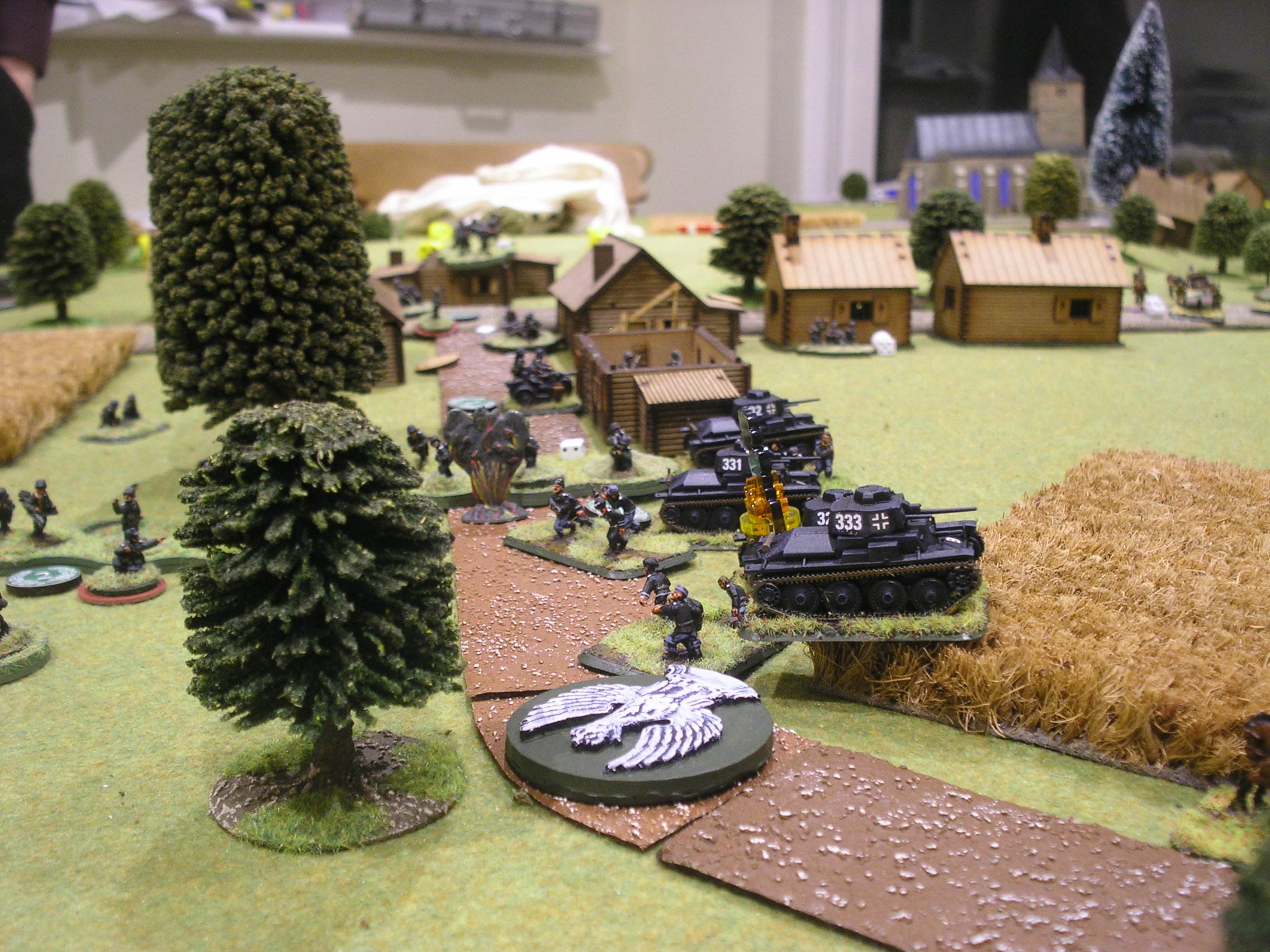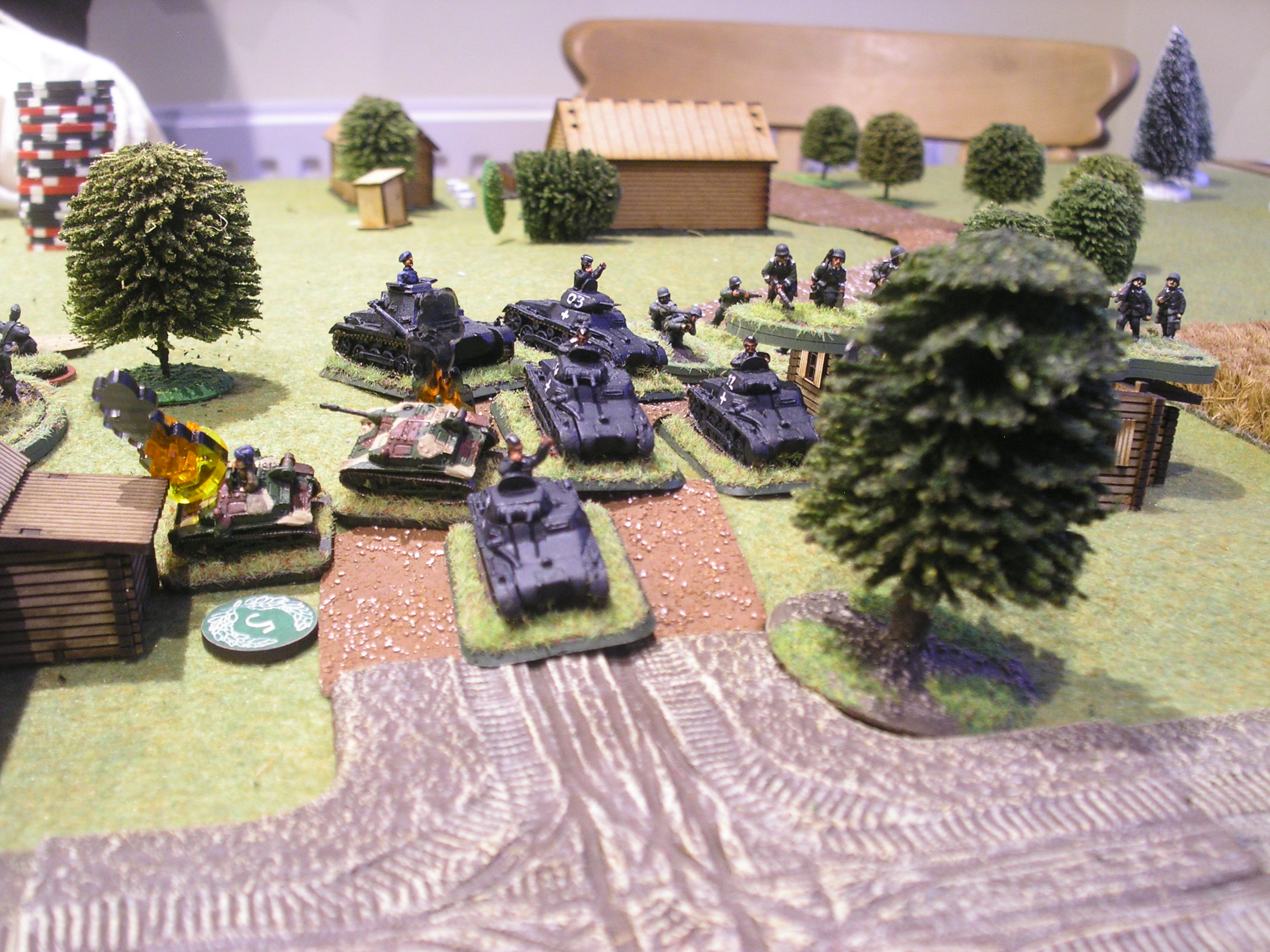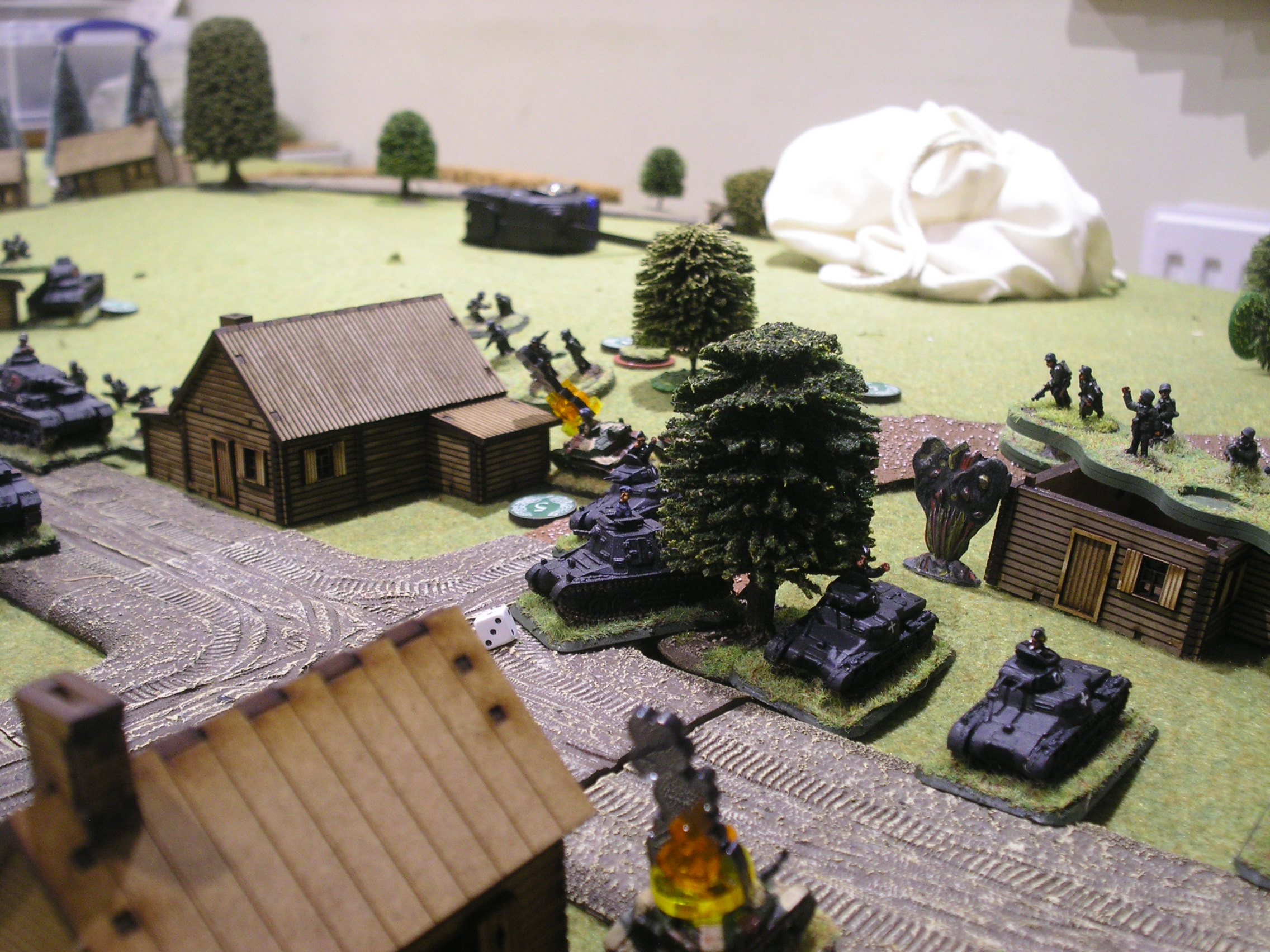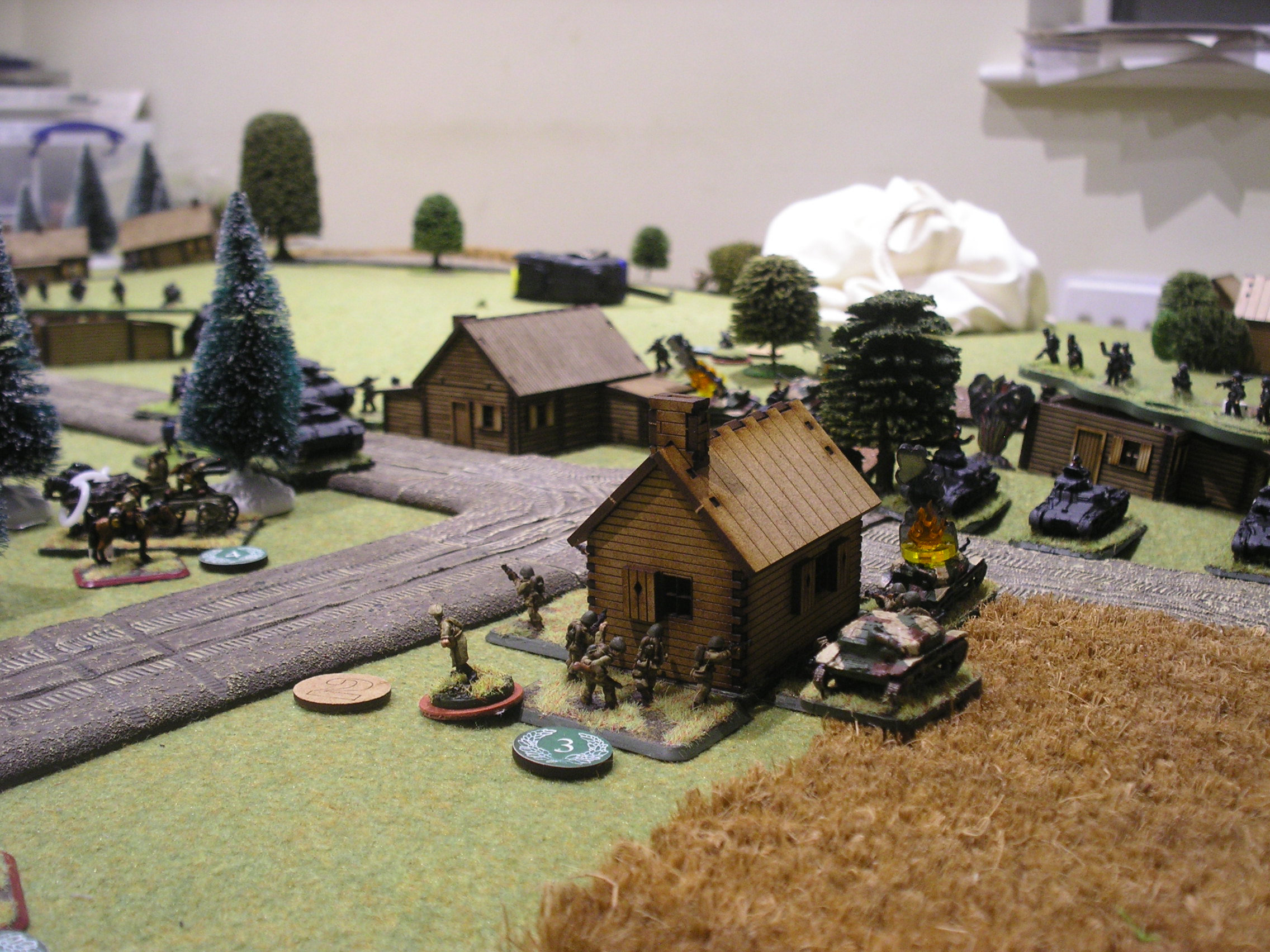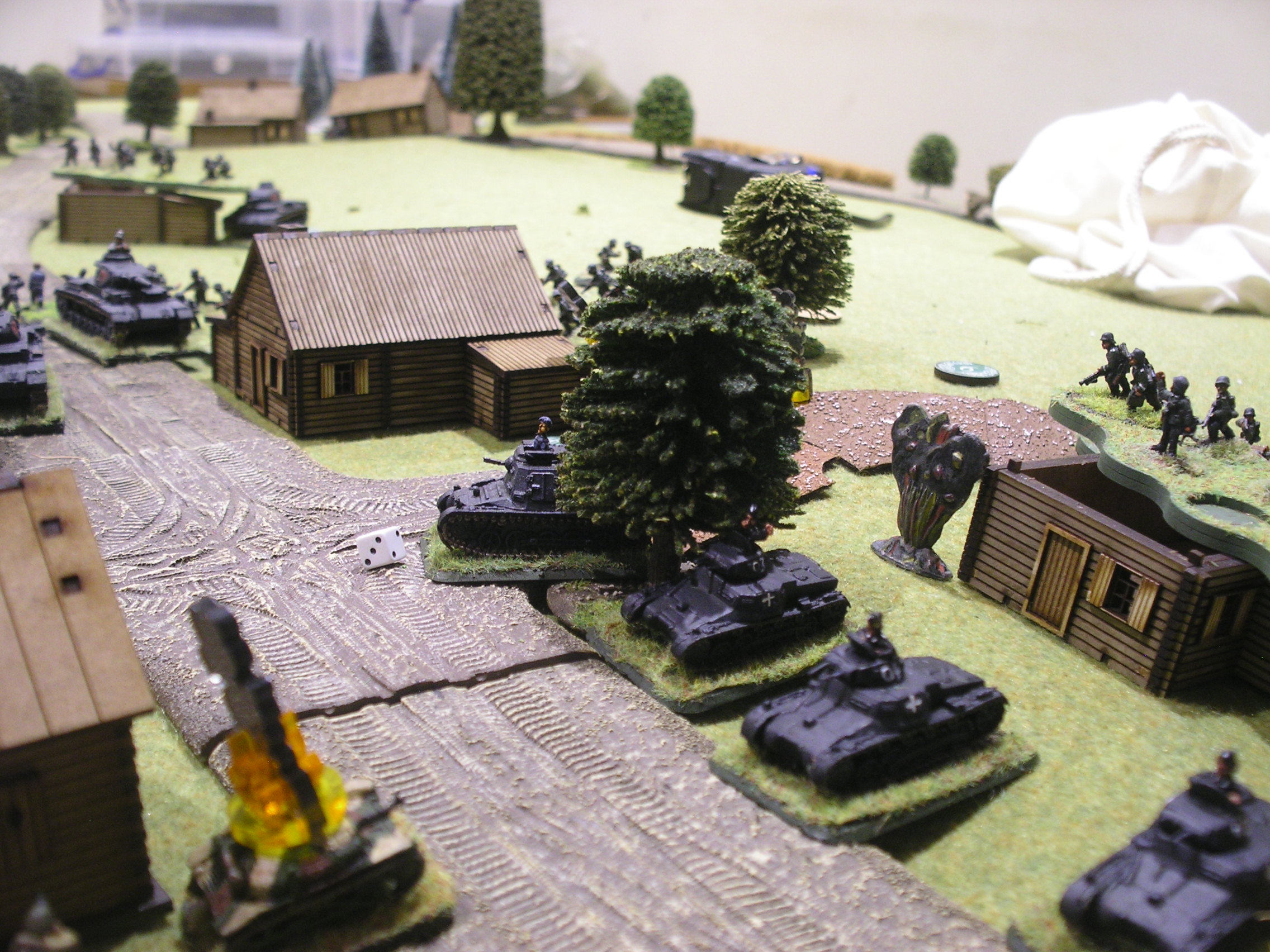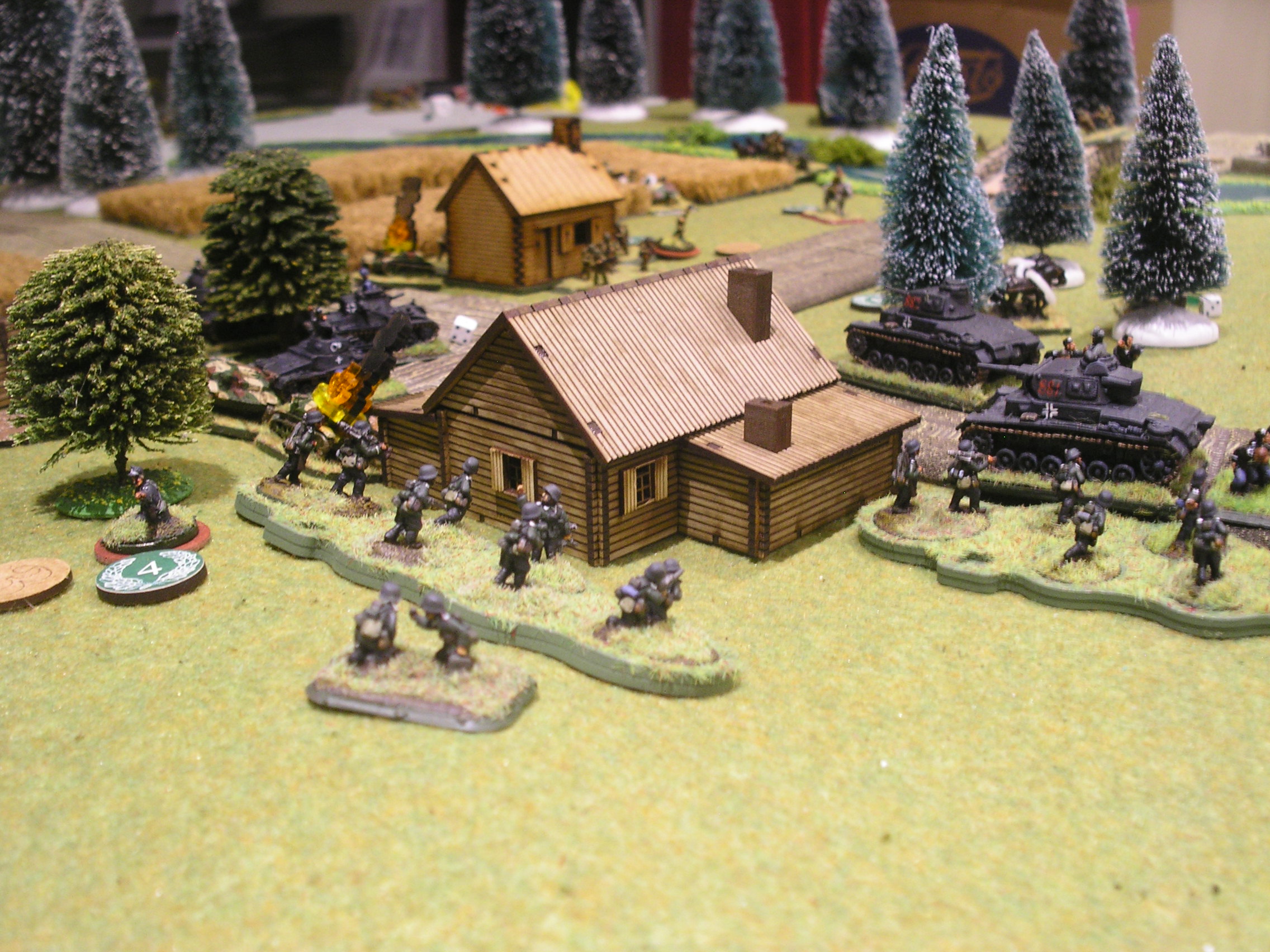Getting off the beach had been Hell, but Captain "Hardcore" Bouldermeir was not a man to lie there and get shot. Through strength of character alone he had kicked, punched and cajoled his men up the bluffs. Now G Company, or what passed for it amid the chaotic intermingling of units, was heading inland to deal with a known German assembly are in the grounds of the chateau to the west of Colleville-sur-Mer.
With him were his own three platoons, a couple of MMGs and two 60mm mortars. He had also picked up a platoon of E Company under the leadership of their sergeant, Bat Guano.
The country lane that led inland was remarkably quite and trouble free, but up ahead the German positions that were marked on his map came closer and closer with every step. To his left a wooded valley ran down towards the beach, where a dense tangle of trees and bushes looked like tough going. What was more crossing the open ground to get into the woods was the least inviting thing he'd seen since the beach. On his right some farmland lay on the plateau above the bluffs, and it was here he chose to funnel his main effort, hopefully approaching the chateau grounds under some cover.
His stopping at a hedgerow he studied the terrain ahead. The turnip fields seemed strangely domestic amid such death and destruction, all seemed quite. Bouldermeir signalled to his men. On the right his first platoon skirted further west before rushing inland towards a small farm yard. On his left his second platoon was forming up to head for an imposing Norman barn where the lane met the main coast road. In the centre `Hardcore' was going to take a chance. He vaulted the hedge, assisted his men with the two MMGs and the small party began to move down towards the coast road.
For Leutnant Rolf Sturmer of the 8th Company, 916th Grenadier Regiment, the day had been one of confusion. With the Americans landing on the beach his force, an under-strength company, had been ordered to remain in their bivouacs in the grounds of the Chateau at Le Bray, presumably to be able to counter-attack if the enemy broke inland. His orders were to deploy his men to cover the main coast road, and ensure communications between Colleville and St Laurent were not disrupted.
But Rolf was worried. His two platoons in the Chateau grounds could not control the road east to Colleville if any Americans came up the valley where the mill stream ran down to the sea. His limited resources would have to be stretched if he were to cover all the ground that he was responsible for. Turning to Feldwebel Hans Beyer he reluctantly ordered his second platoon to move east and take up positions in Le Bray itself.
No sooner had the Feldwebel and his party left than Sturmer felt the hairs on his neck go up. Surely there was movement along the hedgerow in the fields across the coat road? He moved silently to his two MMG teams. "Achtung!". He peered through the dense hedgerow that marked the edge of the Chateau grounds. Before his eyes a large American chewing an oversized cigar vaulted the hedge and then seemed to pause. Now an infantry squad was moving forward, while two machine guns were manhandled across the hedge.
Amid the ornamental gardens and shrubbery Leutnant Sturmer held his breath. The gunner next to him prepared his weapon, holding fire until the Americans were in the middle of the field "FEUR!". Two MG42s opened up on the advancing Americans. The first squad took the full force of the fire, disintegrating and seeking cover amid the furrows. The German mortars now joined in, as their light shells whistled overhead to land with a satisfying crump amid the dismayed Americans.
"Holy Shit" said Bouldermeir, "that's my only Goddam cigar ruined!". This was no way to die. Standing up amid the hail of bullets the Captain bellowed to his men, for a moment they rose, ready to do his bidding, but a further hail of lead had them scrabbling amid the French soil once again.
On the right Lieutenant Joey Gravellini rushed into the farmyard. Wrenching at the door of the farmhouse, intent on seeking cover, he was dismayed to find the house was in fact a store, and a full store at that. As the Lieutenant attempted to clear room in the building his platoon came under fire from the Germans across the road. The leading squad was scythed down amid the dirt before the lieutenant could make room for his men, some in the store, others grovelling behind it, seeking to place the building between them and their assailants.
Off to the left of Captain Bouldermeir the US second platoon was making its run for the large stone barn. The German machine gunners were enjoying what was a target rich environment, and their fire, though less death dealing than before, pinned the US troops short of their objective. Only the actions of Sergeant "Dutch" Kapp kept the men moving up to the barn.
On the American right Lieutenant Gravellini was the first Officer to die, as he directed his mens' fire into the German infantry. His platoon, by now decimated was down to one effective squad, and these were huddled behind the store house seeking cover. In the middle Captain Bouldermeir had finally succeeded in getting his machine gun teams into the next field, but only thanks to the Germans being distracted by Sergeant Kapp and his boys. The American force was being decimated whilst barely denting the German defenders.
In a crisis Captain Bouldermeir acted instinctively, he reinforced failure. His final platoon, along with one from E Company were brought forward.
There are men who are popular leaders, and there are men who are not. In the mess Lieutenant Dullard D.Twatt had never been much liked. Indeed men who hailed from his home town reported that everyone considered him the coward of the county. But war throws up the strangest heroes.
Moving swiftly up behind the large barn the Lieutenant rallied his men. "Okay boys, I ain't standing here getting' shot down like a pile of hogs. We're going in to get those Krauts. Follow me!". And with a bound he was at the head of his platoon hurling grenades into the German infantry that lined the hedge across the road. It was a fierce fight, but a brief one. Under pressure the German infantry fell back into the ornamental garden, shaken.
Less successful was Sergeant Buck Colcannon, who leading Lieutenant Twatt's second squad ran smack into a German machine gun position supported by infantry. Horrific loses saw the remnants of the squad surrender, whilst Colcannon was killed, or so it was thought. On his release from a POW camp in 1945 the big sergeant admitted that he in fact fell drunk into a ditch and awoke in captivity some hours later.
On the far right Sergeant Bat Guano was equally aggressive. Crossing the road at the rush he broke through the hedge and attacked the German positions from the flank. But Leutnant Sturmer had out-though him. Realising some while ago that the Americans were an isolated party he had recalled Feldwebel Beyer from Le Bray, and a second line now cut swathes through the American ranks. From the chateau the newly arrived MMG that had accompanies the 2nd platoon on its circuitous march now opened up on Twatt's men. The only remaining platoon under Sergeant Kapp was not strong enough to break through to the Chateau. The Americans pulled off to lick their wounds.
By the end of the battle the Germans had lost most of their units that had been defending the northern edge of the chateau. Two squads and one MMG had been effectively wiped out, only Leutnant Sturmer and his MMG team survived to withdraw to the Chateau to form a strong position there. The American forces had lost their first platoon, with the third down to one squad that was totally incapacitated by wounds. The fourth was now down to one squad and that under heavy fire and pinned by wounds. The second platoon had suffered little, but was insufficiently strong to launch an assault on its own. Captain Bouldermeir had himself been killed running back to attempt to rally a unit and keep the advance going. His death saw the end of the attack.
A victory for the Germans who risked everything by spreading themselves thinly and presented a hard crust that, had it broken at any point, would have seen the whole position fall apart. Their decision to bring their second platoon back to the chateau was done in the nick of time to allow a second line to form and stop the US break-in. It must be said that the US dice throwing on the day was absolutely abysmal. Three dice for firing would not infrequently result in 1,1,1, whereas three dice for hits would come up 6,6,6. Nevertheless they nearly made it, and were only frustrated by some excellent decisions from the German players.
This was scenario Nine of the D-Day supplement, with Bouldermeir and company standing in for Captain Joseph Dawson, Lieutenant John Spalding and Sergeant Phil Streczyk who, on D-Day, did rather better that we saw last night!
For those that are interested this scenario is a follow on from the one that appeared in the Christmas Special.
Richard Clarke



















